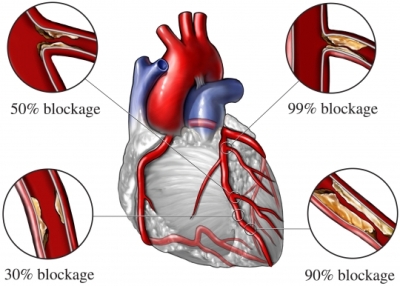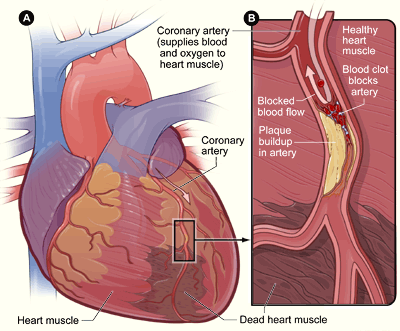|
|
| A heart attack is the death ofor damage to heart muscle because the supply of blood to the heart isseverely restricted or blocked. Heart attacks also are calledmyocardial infarctions (MIs).
Demographics
Heart attack is the leading cause of death in the United States. More than 1.5 million Americans experience a heart attackevery year, and between 500,000 and 700,000 die. Worldwide, heartattacks cause 12 million deaths each year. Most heart attacks are theresult of years of silent but progressive coronary artery disease(CAD); a heart attack may be the firstsymptom of the disease. According to the American Heart Association,63% of women and 48% of men who died suddenly of coronary arterydisease had no previous symptoms.
Description
A heart attackoccurs when one or more of the coronary arteries that supply blood tothe heart are completely or substantially blocked, and not enoughoxygen reaches the heart (a condition called ischemia). The blockageusually is caused by atherosclerosis, the build-up of plaque in theartery walls, and/or by a blood clot in a coronary artery. Much lessoften, a healthy coronary artery has a spasm, and blood flow to part ofthe heart suddenly decreases or stops. Coronary artery spasm in young,healthy individuals is most often brought on by methamphetamine orcocaine use.
About half of all people who have heart attackswait at least two hours before seeking help. This increases theirchance of death or permanent disabled. The longer an artery remainsblocked during a heart attack, the more damage will be done to the heart. Therefore, it is important to recognize the signs of a heart attack and seek prompt medical attention at the nearest hospital with 24-hour emergency cardiac care.
Aboutone-fifth of all heart attacks are silent, that is, the individual doesnot know one has occurred. Although the person feels no pain, silentheart attacks still damage the heart.
The outcome of a heart attackdepends on where the blockage is, whether heart rhythm is disturbed,and whether another coronary artery supplies blood to that part of theheart. Blockages in the left coronary artery usually are more seriousthan in the right coronary artery. Blockages that cause an arrhythmia,an irregular heartbeat, can cause sudden death. |
 |
Major Risk factors
Major risk factors significantly increase the risk of coronary artery disease. Those which cannot be changed include:
- Heredity. People whose parents have coronary artery disease are more likely to develop it. The risk of heart attack is highest for those who have a male parent or sibling who has had a heart attack before age 45 or a female parent or sibling who has had a heart attack before age 55.
- Gender. Men under the age of 60 years of age are more likely to have heart attacks than women of the same age.
- Age.Men over the age of 45 and women over the age of 55 are considered atrisk. Older people (those over 65) are at increased risk of dying froma heart attack. Older women are twice as likely to die within a few weeks of a heart attack as men of the same age.
Major risk factors that can be modified through lifestyle changes include:
- Smoking.Smoking greatly increases both the chance of developing coronary arterydisease and the change of dying from it. Smokers are more than twice aslikely to have a heart attack and havetwo to four times the risk of non-smokers of sudden cardiac death. Theyalso are more likely to die within an hour of a heart attack. Exposure to second-hand smoke also increases risk.
- Highcholesterol. Cholesterol is a soft, waxy substance that is produced bythe liver, as well as obtained from eating cholesterol-containing foodsuch as meat, eggs, and other animal products. Cholesterol level isaffected by age, sex, heredity, and diet.
- High blood pressure(hypertension). High blood pressure makes the heart work harder andover time weakens it. It increases the risk of heart attack,stroke, kidney failure, and congestive heart failure. A blood pressureof 140 over 90 or above is considered high. As the numbers increase,high blood pressure goes from being categorized as Stage 1 (mild) toStage 4 (very severe). African Americans are at increased risk ofdeveloping severe hypertension.
- Obesity and lack of physicalactivity. The heart of an obese individual must work harder, while lackof physical activity increases the risk of coronary artery disease.Even modest physical activity is beneficial if done regularly.
- Useof certain drugs or supplements. In the late twentieth century, ephedra(ma huang) gained popularity as a weight-loss supplement. The herb cancause life-threatening side effects, including heart attack,stroke, and seizures. Since April 2004, sale of products containingephedra have been banned in the United States, although it may still beobtained illegally over the Internet. Hormone replacement therapy (HRT)was once believed to help prevent heart disease in postmenopausalwomen. However, the Women's Health Initiative, a very large clinicaltrial, found the opposite to be true. Potential adverse effects of HRTinclude increased risk of heart attack, stroke and blood clots, and an increased risk of breast cancer.
|
 |
Contributing risk factors
Contributing riskfactors have been linked to coronary artery disease, but theirsignificance or prevalence cannot always be demonstrated or quantified.Contributing risk factors include:
- Diabetes mellitus. Therisk of developing coronary artery disease is seriously increased forindividuals with diabetes. More than 80% of diabetics die of some typeof heart or blood vessel disease.
- Emotional factors. Long-termstress, anger, and guilt are thought to contribute to the developmentof coronary artery disease. Stress, the mental and physical reaction tolife's irritations and challenges, increases the heart rate and bloodpressure and can injure the lining of the arteries. Evidence shows thatanger increases the risk of dying from heart disease and more thandoubles the risk of having a heart attack right after an episode of anger.
Causes and symptoms
Heartattacks generally are the result of severe coronary artery disease.Most heart attacks are caused by blood clots that form onatherosclerotic plaque. These may break lose and travel through thecirculatory system causing heart attackor stroke (blockage of an artery to the brain). Certain major riskfactors increase the chance of developing coronary artery disease. Someof these can be modified and some cannot. People with a greater numberof risk factors are more likely to develop coronary artery disease.
More than 60% of people who have a heart attack experience symptoms before the heart attack occurs. These symptoms sometimes occur days or weeks before the heart attack. Sometimes, people do not recognize the symptoms of a heart attack or are in denial that they are having one. Typical symptoms include:
- Uncomfortablepressure, fullness, squeezing, or pain in the center of the chest(angina) that lasts more than 30 minutes. Warning pains before a heart attack may last a shorter time or may go away with rest and then return.
- Pain that spreads to the shoulders, neck, arms, or jaw.
- Chest discomfort accompanied by lightheadedness, fainting, sweating, nausea, or shortness of breath.
All of these symptoms do not occur with every heart attack,and most have other common causes. Nevertheless, person with any ofthese symptoms should immediately call an emergency rescue service(recommended) or be driven (but not drive themselves) to the nearesthospital with a 24-hour cardiac care unit. The advantage of calling anemergency rescue service is that life-saving treatment may begin whilethe individual is in transit to the hospital. |
 |
|
|
Posted By: adminThursday, June 17, 2010 Total views: 9145 |
blog comments powered by
|